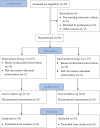Efficacy of cervical mobilization with post-isometric relaxation in managing mechanical neck pain, ROM, and functional limitations associated with myofascial trigger points
- PMID: 38206736
- PMCID: PMC10754601
- DOI: 10.1097/MD.0000000000036710
Efficacy of cervical mobilization with post-isometric relaxation in managing mechanical neck pain, ROM, and functional limitations associated with myofascial trigger points
Abstract
Background: Sedentary lifestyle, age-related degenerative changes or traumatic injuries leads to cervical spine structural mal-alignment, which results in neck pain and other symptoms. Various therapeutic exercises and manual techniques have been proven to be beneficial in terms of managing these symptoms. This study aimed to determine the combined effects of cervical mobilization and post-isometric relaxation (PIR) technique on managing neck pain, cervical side flexion range of motion, and functional limitation in participants with mechanical neck pain linked with myofascial trigger points.
Methods: This study followed a 2-arm, parallel-group, pretest-posttest randomized comparative design. Thirty participants with mechanical neck pain associated with myofascial trigger points aged 30.87 ± 4.45 years were randomly allocated to Groups 1 and 2. Group 1 received conventional intervention, PIR, and cervical mobilization techniques while Group 2 received conventional intervention and PIR technique only. Neck pain, muscle tenderness, cervical range of motion, and functional limitations were assessed using a visual analog scale, pressure pain threshold (PPT), goniometer, and neck disability index (NDI) questionnaire, respectively at baseline on day 1 and post-intervention on day 7, 14, and 21. Wilcoxon signed-rank test and the Mann-Whitney U test evaluated within-group and between-group analyses, respectively. Statistical significance was established at a 95% confidence interval, indicated by P < .05.
Results: Significant differences (95% confidence interval [CI], P < .05) were observed within each group for all the outcomes scores when compared to the baselines across multiple time points. Significant variations were observed between the groups when comparing visual analog scale and NDI scores at weeks 1, 2, and 3 post-interventions. In contrast, insignificant differences (95% CI, P > .05) were observed for side flexion range of motion and PPT compared at weeks 1, 2, and 3 post-interventions except for PPT at week 3 post-intervention (95% CI, P < .05). Additionally, Cohen d test revealed the superiority of group 1 over group 2 in reducing pain and functional limitations and improving cervical side flexion range of motion and PPT.
Conclusion: The combination of cervical mobilization and Post-isometric relaxation techniques was discovered to effectively alleviate neck pain and enhance functional abilities when contrasted with the application of post-isometric relaxation alone in patients with mechanical neck pain linked with myofascial trigger points.
Copyright © 2023 the Author(s). Published by Wolters Kluwer Health, Inc.
Conflict of interest statement
The authors have no conflicts of interest to disclose.
Figures
References
-
- Childs JD, Cleland JA, Elliott JM, et al. . Neck pain: clinical practice guidelines linked to the international classification of functioning, disability, and health from the orthopaedic section of the American Physical Therapy Association. J Orthop Sports Phys Ther. 2008;38:A1–A34. - PubMed
-
- Ssavedra-Hernández M, Castro-Sánchez AM, Fernández-de-las-Peñas C, et al. . Predictors for identifying patients with mechanical neck pain who are likely to achieve short-term success with manipulative interventions directed at the cervical and thoracic spine. J Manipulative Physiol Ther. 2011;34:144–52. - PubMed
-
- Clair DA, Edmondston SJ, Allison GT. Physical therapy treatment dose for nontraumatic neck pain: a comparison between 2 patient groups. J Orthop Sports Phys Ther. 2006;36:867–75. - PubMed
Publication types
MeSH terms
LinkOut - more resources
Full Text Sources
Medical
Research Materials


